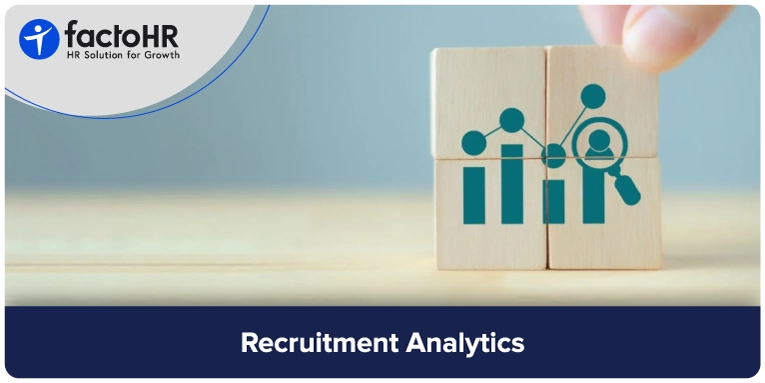9 Recruitment Analytics Metrics to Track the Hiring Process

Table of Contents
Think of an organization where hiring decisions are not based on just gut feelings but are led by proper guidance through powerful data insights. In this business market, this is not just a vision but a reality that can be acquired with the use of recruitment analytics.
Data is crucial in the modern hiring process. Accurate recruitment data helps organizations understand their recruitment process and attract talent. Advanced analytics can also help companies make smart decisions that improve the recruitment process. The market has shifted to a more candidate-centric approach, where staying updated with talent acquisition practices is necessary. This is where recruitment analytics comes into the picture.
This article will discuss the key recruitment metrics to track and the stages in recruitment analytics. It will also cover some of the common challenges in recruitment analytics and how to solve them to improve the efficiency of the hiring process.

What is Recruitment Analytics?
Recruitment analytics is a process of collecting and organizing data gathered during the recruitment process to identify areas for improvement. The analysis is done to understand the efficiency of the hiring process and find loopholes. The interpretation of the data from hiring processes helps identify trends and make informed decisions. Some of the examples of how recruitment analytics is used are mentioned below.
- Simplify the hiring funnel
- Identifying effective sourcing channels
- Reduce cost-per-hire
Recruitment or hiring analytics simplifies recruitment strategies and improves the process. Those organizations who have implemented talent acquisition analytics have seen an enhancement in hiring higher-quality candidates.
HR professionals, with the help of recruitment analytics, can calculate their hiring metrics and improve the strategy wherever needed. So basically, this process is about knowing and understanding the patterns for hiring and selecting candidates. The process helps organizations to find answers to the important questions about the recruitment process. These questions are:
- What are the challenges companies face in the recruitment process?
- Which sourcing channels provide the highest-quality candidates?
- Where do the most candidates drop out of the recruitment funnel?
- What common traits do successful hires have?
- What are the hiring needs of the organization in comparison to historical data?

Benefits of Recruitment Analytics for Hiring Success
Recruitment analytics can benefit organizations in many ways. Some of these are:
Enhances Quality of Hire
Organizations, with the help of data and metrics, can find the most effective channels for attracting top talent. This will help companies to invest more in these sources and choose the best candidates.
Reduces Time-to-Hire
HR teams make use of accurate data to study various aspects included in the hiring process. They can find blockages for slow or inefficient processes, like delays in interview sessions. This helps them take corrective actions and reduce time-to-hire.
Lowers Cost-Per-Hire
It benefits the organization by reducing unnecessary expenses and lowering the cost-per-hire. Distributing funds for hiring in the right direction can help reduce recruitment process costs.
Improves Candidate Experience
From the beginning of the hiring process, employees form an impression of the company. That is why it is important to identify the areas where a candidate’s experience can be negative. This can also help remove unnecessary steps in the process.
Increases Retention Rate
These analytics help understand the factors for high employee retention. These can be career development opportunities or good incentives. If these are the reasons for turnover, employee wellness programs and an incentive strategy can be promoted.
Enables Proactive, Predictive Hiring
Recruiters can get insights into the industry trends with the data received from recruitment analytics. This will help understand demand and supply movement in the job market. Recruitment policy and strategy can be changed accordingly for better results.

9 Key Recruitment Metrics to Track
There are various recruitment metrics that can be tracked for organizations that want to improve their hiring process. These are mentioned below for better understanding.
Time-to-Hire
Time-to-hire represents the time taken to fill a vacancy or the number of days required to fill the job position. It is calculated from the time of application till accepting the job. If the calculation shows that the vacancy was filled after a long time, the process is slow and inefficient. The main goal of this metric is to speed up the recruitment process and also to choose the right employee for the job.
Time-to-Fill
Time-to-fill refers to the days it takes to fill a job opening. The number of days starts from the approval of the job requisition to the candidate accepting the offer. Note that the time-to-hire metric is part of the time-to-fill metric. This metric helps HR professionals understand the hiring process and its effectiveness.
Cost-Per-Hire
The cost-per-hire metric is the average cost of hiring a new candidate. This includes all the expenses related to the recruitment process. Some of these expenses are advertising and recruitment agency fees. The cost-per-hire is derived by dividing total expenses by the number of hires. This way, companies can measure the resource allocation and know if the expenses are too much (or too little).
Quality of Hire
Quality of hire is a performance measurement of the value a new employee will bring to the organization. This talent acquisition metric estimates whether the new candidate can fit into the organization’s culture and job role and whether the new hire can bring success to the business. The objective here is not just to fill the vacancy but to have a long-term value and impact for the company.
Source of Hire/Sourcing Channel Effectiveness
Which hiring/sourcing channels can give the best results? The answer to this question is from which sources talented candidates are getting hired. There are various channels through which a candidate can find and apply for a job. This metric shows which channels are the most effective for attracting qualified candidates. HR professionals can also understand which sources are working and which aren’t. Some of the ways a candidate can find a job are:
- Employee referrals
- Social media platforms
- Recruitment agencies
- Career websites
Applicant-to-Hire Ratio
Applicant-to-hire metric is the ratio of the number of applicants to the number of hires for a vacancy. This ratio helps understand the effectiveness of the recruitment process. A higher ratio means inefficiency in the sourcing and interview processes. This will lead to long vacancies for a position and an increase in time-to-hire. A lower ratio shows a simplified process in talent acquisition.
Offer Acceptance Rate
Offer acceptance rate is the percentage of job offers provided that are accepted by the candidates. This rate can be derived by dividing the number of accepted offers by the total number of offers made. The offer acceptance rate shows the effectiveness of the hiring process. A higher ratio indicates that the company matches the candidate well. This can be due to good pay and a corporate culture.
Retention Rate (Post-Hire)
Retention rate gives the percentage of employees who stay loyal to the company for a given period of time. It is divided by the number of employees who remained by the number present at the start of a definite period and then multiplied by 100. A high retention rate proves that the company has a healthy and positive culture. This also shows workforce stability and employee satisfaction.
Funnel Analysis
Funnel analysis is a process of tracking and analyzing candidates’ flow in the hiring process. This process starts with attracting candidates and ends with making job offers. The results from these analyses help confirm that each stage is working efficiently. Funnel analysis also helps identify areas for improvement and take corrective actions to improve efficiency.
The term funnel here means that the start of the process has a pool of candidates, and the number gets smaller with each step passing. At the end, the organization has the most talented applicants.

Three Stages of Recruitment Analytics
Recruitment analytics is divided into three levels. These are mentioned below for further information.
Operational Reporting
Operational reporting is one of the first stages in the Hiring Process Analytics. It includes monitoring daily recruitment activities to simplify operational efficiency. This includes analyzing day-to-day functions and making changes if needed. These tasks and processes are carried out to obtain operational efficiency. It is observed that 45% of leaders spend almost half their working hours on routine talent acquisition tasks, which can be automated through AI. Once the tracking and evaluation are done, improvements can be made for smooth operations. Some of the metrics included here are:
- Cost per hire
- Time to fill
- Time to hire
- Number of applicants per job opening
- Selection ratio
- Manager satisfaction
- Source of hire
If the hiring process is slow and inefficient, HR professionals can identify areas for improvement. Proper decisions can be made with the help of an Applicant Tracking System (ATS). This system organizes candidates’ information and filters their resumes based on qualifications and keywords. The organized data can help HR professionals optimize hiring and make informed decisions.
Advanced Reporting (Diagnostic)
After operational reporting, the next stage is advanced reporting. Advanced reporting in hiring analytics includes how HR functions are working for the hiring and selection process. This is done by collecting and analyzing data accurately from various sources. Some data collection sources are surveys and questionnaires, which help understand a candidate’s journey from the start. This is also known as journey mapping, wherein the candidate’s experience is visualized till the onboarding process. Some of the metrics included here are:
- Recruitment funnel cost
- Application drop-off rate
- Effectiveness of sourcing channels
- Net Promoter Score or NPS for candidates
- Heat maps
- Employer branding effectiveness
This reporting level helps HR teams understand the difficulties they face and take action. This will help attract potential employees and improve brand reputation. Advanced reporting provides in-depth analysis of the recruitment process and identifies issues related to it. All of this helps in taking practical hiring actions.
Predictive Analytics
Predictive analytics is the last phase in the recruitment process. It includes an analysis of all the statistics about the hiring processes. It helps in creating the hiring model strategies and predicting future needs. The data is collected from various sources, which helps to understand the future patterns in hiring. Some of the metrics included here are:
- Predict candidate success
- Contribute to employee attrition
- Improve sourcing channels
- Enhance candidate experience
- Reduce bias in hiring
In this process, HR professionals gather a large amount of data from various platforms like HRIS and analyze the improvement needs. This helps them make informed decisions with the help of historical data. When the HR teams have the knowledge of what could happen in the future, the processes can be improvised. Even the hiring success can be predicted, that is, from the job application to the onboarding process. For an organization, better hiring outcomes result in overall operational efficiency and improved brand reputation.

Best Practices for Implementing Recruitment Analytics
Any organization can follow these practices to enhance and optimize its talent acquisition process.
- Make sure that the right HR key performance indicators are used for specific business needs.
- Collect the right data to track the recruitment metrics for effective decision-making.
- Recruitment software should provide insights that any organization needs through the hiring dashboard.
- Make use of an Applicant Tracking System (ATS) to manage the recruitment process and improve efficiency.
- The use of recruitment software enhances the overall hiring process and identifies areas for improvement.
- Regularly review and monitor the overall hiring process.
- Follow the rules and regulations related to recruitment and protect the candidate’s data.
Common Challenges and How to Overcome Them
While analytics in recruitment offers many benefits, it also comes with challenges. Some of them are mentioned below for further information.
Data Fragmentation across Systems
Data fragmentation across systems is one of the most common issues any organization faces during the recruitment process. Applicant Tracking Systems (ATS) and job boards are ways data can be integrated for decision-making. When the data is not integrated, it leads to inconsistency and delays in the hiring process. Data-quality checks and powerful integration tools can be applied to manage this issue.
Resistance to Analytics Adoption
Change in technologies and processes can be difficult for employers and employees. Sometimes, organizations might be unsure about shifting from traditional recruitment practices to a long-term data-driven approach. To change this, understand the reasons for resistance, which can be fear of adoption. Provide HR professionals with training and ongoing support related to the recruitment process. This will make the transition to adopting analytics smooth.
Data Privacy and Compliance
Data privacy is another main challenge any organization is facing today. Protecting candidate information from any unauthorized use is one of the key responsibilities for any organization. Also, protecting candidate data is a legal requirement and a matter of trust from the organization. To solve this problem, a system that protects data and properly complies with regulations must be installed. Data storage of the candidate’s information can be done securely by following the rules and regulations of GDPR.
Technical Limitations & Tool Selection:
The use of technology in the recruitment and selection process is important. But, sometimes due to monetary issues, some organizations may not have the latest tools and software to conduct recruitment analytics. Some of the outdated systems can also negatively affect the process of hiring analytics. To manage this issue, modern core HR solution can simplify the hiring process, like ATS. These systems should be compliant with all the rules and data security measures. To enhance the candidate’s experience, regularly evaluate and change the recruitment process.
Ensuring Accurate, Actionable Data
When the data results are incorrect, the insights will be inaccurate, and the decisions will be wrong. All of these lead to poor and ineffective processes in recruitment analytics. To solve this issue, use tools that can organize the data and provide correct insights for decision-making. Get survey forms filled out by managers and candidates to identify gaps. HR professionals can improve the results and outcomes with these insights.

Final Words
In conclusion, we can now understand that recruitment analytics play an important role for any organization that aims to improve its hiring process. It has become necessary for businesses to analyze and optimize the recruitment process. Recruitment analytics is changing the hiring processes with the help of accurate data and insights. This will improve the hiring processes and identify the future trends with predictive analytics.
By improving the quality of hires, organizations can coordinate their long-term goals. They can also use analytics in the recruitment process to acquire top talent and grow the business toward success and scalability.
What is the Role of Job Analysis in Recruitment?
Job analysis confirms that the recruitment and selection process is effective and goal-oriented. HR teams know what skills and responsibilities are needed in a job role. This will result in accurate job descriptions and better candidate matching.
What is HR Analytics?
HR analytics is collecting and analyzing HR-related data for improving business results. HR professionals, with the help of HR reporting, can understand various trends and predict future outcomes. It helps in making informed decisions about the workforce and their performance.
How to Measure the ROI of Recruitment Analytics?
To measure the return on investment of recruitment analytics, there are various steps to follow. They are:
- Define the recruitment expense budget
- Track key metrics like cost per hire, offer acceptance rate, etc
- Compare costs with benefits
- Identify areas for improvement
- Change the strategy accordingly
Grow your business with factoHR today
Focus on the significant decision-making tasks, transfer all your common repetitive HR tasks to factoHR and see the things falling into their place.

© 2025 Copyright factoHR


